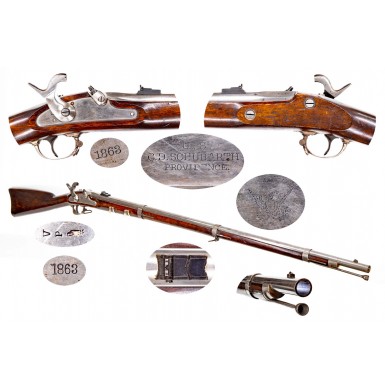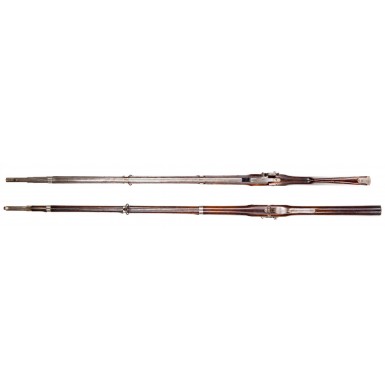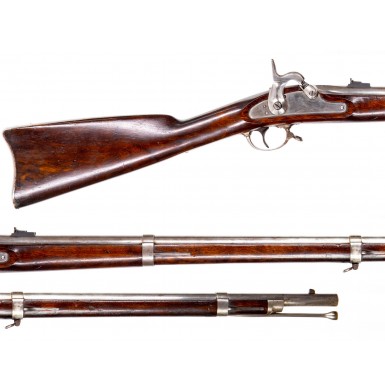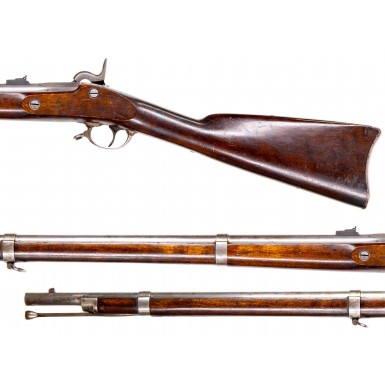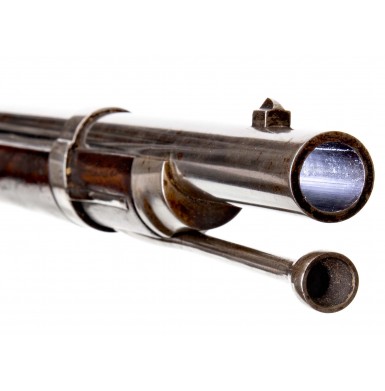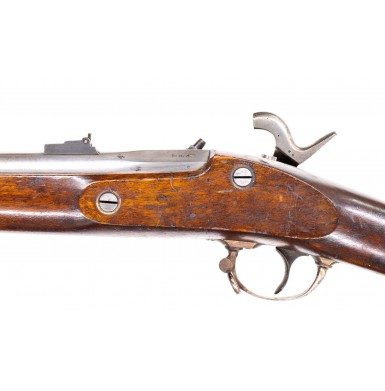Extremely Rare & Fine C.D. Schubarth Contract US Model 1861 Rifle Musket
- Product Code: FLA-3726-SOLD
- Availability: Out Of Stock
-
$1.00
During the course of the American Civil War a large number of contracts were let by the Ordnance Department to various makers to produce the US Model 1861 Rifle Musket. Some of these contractors were established gun makers, while others had never been involved in the arms production business. The success of these contractors in producing the contract arms ranged from very successful to utter failure, with many of the contractors falling between these two extremes. In some cases, the contracts were obtained via political influence rather than by the reputation and good efforts of those seeking the contracts. In such cases, it was often expected by those who exerted the political influence that a “commission” would be paid by the contractor to the politician who arranged the deal. Such political graft was somewhat commonplace during the 19th century in the United States, and amazingly was not actually illegal as a matter of law. While it was certainly unethical, it was apparently accepted as matter of standard practice by the creatures that inhabited the Washington City swamp during that time. It was the contract for US Model 1861 Rifle Muskets granted to Casper D. Schubarth that resulted in a clause being added to future Ordnance Department contracts that read in part:
“And the said parties of the first part (contractors) do further engage and contract that no member of Congress, officer of the Army or any agent of the military service, or other person forbidden by law to do so, shall be admitted to any share of part of this contract or agreement, or to any benefit to arise thereupon.”
The story of Casper Daniel Schubarth begins in Norway, where he was born in 1839. Casper’s father served as the local equivalent of the sheriff in the town of his birth. Young Casper apparently trained as a gunsmith during his early life, likely in the roll of an apprentice to a Norwegian gunmaker. Around 1850, Casper emigrated to the United States and apparently settled in Massachusetts. In 1853 he married Sarah Lincoln of Dighton, MA and the couple apparently settled in Taunton, MA. It is likely that during his first few years in the United States that Casper continued his training as a gunmaker by working for one of the many gunmakers in Massachusetts. Casper Schubarth first appears in period directories in 1855, operating as a gunsmith located at 6 North Main Street in Providence, RI. There he had a small two-room shop and likely did what most small gunsmiths of the period did; repaired guns, made a small number of new guns, retailed guns by larger manufacturers and sold the accessories needed by gun owners. He also apparently tinkered and experimented with gun designs and received US Patent #32,895 for an “Improvement In Breech-Loading Firearms” on July 23, 1861. The dovetailed hinged breech design looks quite similar to that of the Smith Carbine, with the difference being that the Schubarth design relays upon a long loop lever to actuate the action for opening and closing, rather than the Smith’s push button that releases the top mounted spring lock. Like the Smith, the Schubarth design utilizes a proprietary waterproof cartridge. The patent drawings show an elegant design that appears simple and effective. Apparently Schubarth was convinced of the potential of his design and started to search for financial backers to help him produce the guns and hopefully help him obtain a US military contract.
At this point, Schubarth entered into a tentative agreement with brothers Amos D. and James Y. Smith. The Smith brothers had moved to Providence in 1826 and were involved in the lumber trade, working for a James Aborn. The pair quickly changed course and started to work in the wholesale grocery business and began to enter the textile trade by investing in local mills. By the 1840s their wholesale grocery business was quite successful, and they were also the owners of several local textile mills. By the outbreak of the Civil War the pair were both rich and well connected and were major players in both the financial and political life of the city of Providence and the state of Rhode Island.
The brothers introduced Schubarth to Republican Rhode Island senator James F. Simmons, in hopes that Simmons could connect Schubarth to the right people to obtain a contract for Schubarth’s carbine design. Simmons apparently arranged meetings with Secretary of War Simon Cameron, Chief of Ordnance James W. Ripley and Captain Andrew A. Harwood the Chief of the Bureau of Ordnance & Hydrography for the United State Navy. None were receptive to the design and no orders for the Schubarth carbine were forthcoming. General Ripley noted on October 10, 1861 that “The breech-loading arm was brought to this office yesterday, and the party bringing it in was told that it was not considered a suitable arm for the military service and that we did not want to contract for it.”
In desperation, Schubarth offered to undertake the manufacture of US Model 1861 Rifle Muskets. More than likely this was an attempt to “get his foot in the door” and make it more likely that his breechloading design might be given further consideration at a later date. Due to the influence of Senator Simmons, Schubarth received a contract for 20,000 US M1816 Rifle Muskets at the price of $20 each. Simmons apparently strong armed Secretary of War Cameron, who passed the order to General Ripley, who offered the contract to Schubarth on October 11, 1861 only one day after writing that he had no interest in Schubarth’s breechloading design.
However, the contract for 20,000 stands of arms was a mixed blessing for Schubarth. It was not enough arms to make the tooling and production set up worth undertaking, so Schubarth’s partners pressured him to return to Washington and get the contract increased to a profitable number of arms. Again, relying on Simmons’ help, Schubarth obtained a larger contract for a total of 50,000 stands of arms on November 26, 1861. He also received an invoice from Simmons for $50,000, which Simmons considered his “commission”. At this point the Smith brothers decided they did not want to be involved with what they considered an unethical bribe being paid to Simmons and they exited the stage, leaving Schubarth with no investors and no ability to produce the arms required by the contract or to pay Simmons his money. More than likely James Smith, who had political aspirations himself, wanted no part of a potential scandal. It was a good decision, as he was elected the Governor of Rhode Island in 1862. As a result, Schubarth was left to look for new financial backing for his enterprise.
It is worth noting at this point that while Schubarth was a gunsmith he never intended to fully produce the US M1861 Rifle Muskets. Rather he intended to rely primarily on subcontractors to supply most of the parts and then assemble the guns. On February 15, 1862 Schubarth formed the C.D. Schubarth & Company corporation with the financial backing of his new partners James M. Ryder of Pawtucket, RI and Frederick Griffing of Brooklyn, NY. In order to get the new investors involved, Schubarth had to promise each of them one-third of the profits from the contract. However, things started to go awry when Schubarth explained the commission structure and the payments that were going to be due to Simmons. To emphasize how serious Simmons was about receiving his “commission”, Simmons met with the new partners and requested a written contract regarding the arrangement as well as the signing of promissory notes. Sources are somewhat unclear as to what the final arrangement was, with some indicating that an additional $10,000 was added to the original $50,000 “bribe” and others suggesting that Simmons lowered his price to $20,000. In any event, he apparently left the meeting with two $10,000 promissory notes payable in August and September of 1862, respectively. However, for Schubarth the house of cards was starting to collapse.
In January of 1862, Secretary of War Simon Cameron was replaced by President Lincoln with Edwin Stanton. One of Stanton’s first projects was to look into the large number of outstanding Ordnance Department contracts that were yet to be filled. He was looking for corruption, graft, waste and any form of impropriety. This seemed quite likely on the surface as the Ordnance Department had contracts for more than one million rifle muskets by the time Stanton took over and few of these contract arms had been delivered. In fact, only about 11,000 US M1861 contract rifle muskets would be delivered by the end of 1862! It was also a massive number of guns to have on order, significantly more than the conventional wisdom of the period thought would be necessary to bring the war to a conclusion. Thus, the Holt-Owens Commission was born, which Stanton created at the request of the senate to investigate the contracts and contractors. By May of 1862 Casper Schubarth was subpoenaed to appear before the commission, which he did on June 2, 1862.
Schubarth was facing multiple problems. First, he had yet to deliver any arms under the November 1861 contract, which had initially specified January of 1862 for the delivery of the first 1,000 guns. Although an extension had been granted to Schubarth that allowed the first 1,000 guns to be delivered in May of 1862, that had not happened either. Secondly the details of the arrangement with Simmons had come to the attention of the commissioners and they were looking for answers. During his testimony Schubarth blamed his lack of ability to deliver arms on his subcontractors, laying blame on his barrel producer who could not supply barrels that would not pass proof and other subcontractors who were late in delivering components. Regarding the arrangement with Simmons, both Schubarth and the Senator were amazingly candid. When questioned about the propriety and legality of the “commission” arrangement between himself and Senator Simmons, Schubarth noted that “I understood, on the contrary, that it was customary to make compensation for such services, and I have heard of many cases in which it was said to have been done.” Interestingly the commission agreed that the arrangement was not technically illegal, as the laws governing such arrangements did not explicitly forbid a contractor from paying a government official. While not illegal by the letter of the law, it was certainly a violation of the spirit or intent of the law. The commission found that Schubarth was innocent of any nefarious intentions, suggesting that his foreign birth and his attempt to enter the world of government contracting had led him to believe that what he was doing was standard business practice in America. The commission was harsher with Senator Simmons, who was considered to have taken advantage of both a national emergency and the emigrant Schubarth. The embarrassment of Simmons’ actions was too much for the senate, and Congress quickly passed a bill that made what Simmons had done illegal. President Lincoln signed the bill into law, which stipulated a fine of up to $10,000 and a two-years term in prison as the potential punishment for accepting bribes from contractors. The senate further opened an investigation into Simmons’ conduct which determined that his actions were “entirely inexcusable”. With pressure mounting on him, Simmons resigned from the senate on September 5, 1862 before the senate could vote to expel him, which they almost assuredly would have done.
Casper Schubarth was not completely unscathed as a result of the appearance before the commission. While he did not face any ramifications over the kickback arrangement, the commission did reduce his contract from 50,000 guns to 30,000 guns. The rational was that the reduction represented the guns that had originally been due for delivery that had never been produced. Schubarth returned to Providence and continued to work on the contract, but it would be December 19, 1862 before the first guns were delivered to the Ordnance Department. On that day he delivered 500 rifle muskets, with 254 rated “1st Class” at $20 each, 206 rated “2nd Class” at $19.90 each and 40 rated “3rd Class” at $18 each. He would not deliver any additional guns until April of 1863, when he would deliver an additional 950 guns, with only 685 being “1st Class”, 233 being “2nd Class” and 32 being “3rd Class”. Schubarth would make eight additional deliveries in 1863 with the last on October 14, 1863. In all he would deliver 9,450 guns, with only 4,463 (47%) being “1st Class”. The balance of the guns delivered were either “2nd Class” (4,915 or 52%) or “3rd Class” (72 or slightly less than 1%). While most sources indicate that Schubarth delivered a total of 9,500 guns between December 1862 and October 1863, the detailed breakdown above indicates that he only delivered 9,450. The missing 50 guns appear to be from the April 24 delivery which only includes 950 guns, and not the full 1,000 as did all of the subsequent deliveries. It is possible that 50 of the guns were simply not accepted, thus they were not paid for, even though the they were technically “delivered”. Research by arms collector, historian and author George Moller suggests that only about 500 of the Schubarth arms were delivered with Schubarth marked locks. It is hypothesized that the balance of the guns delivered were either marked by Providence Tool or Alfred Jenks, further suggesting that at least some of the guns Schubarth submitted were not even assembled by him, but rather were produced by other makers. Moller suggests that at least some of the Schubarth deliveries were produced by the Norwich Arms Company.
Due to Schubarth’s inability to deliver arms on the timeline specified by his contract, it was not renewed, and no extension was granted. Thus, no further arms were delivered after October 14, 1863. Schubarth returned to his gunsmithing and hardware business in Providence at the conclusion of the failed contract, where he worked until 1866. He then gave the shop over to his brother. Schubarth moved to New York City in 1866 where he lived until his death in 1908.
Offered here is an extremely rare Casper D. Schubarth Contract US Model 1861 Rifle Musket. The lock of the gun is clearly marked with a {Spread-Winged Eagle} between the hammer and bolster and under the bolster in three lines:
U.S.
C.D. SCHUBARTH
PROVIDENCE
The tail of the lock is dated 1863. The breech of the barrel has the matching 1863 date and the left angled flat is stamped with the usual V/P/{Eagle Head} inspection and proof marks. The left flat of the barrel is marked with a single 1/10” tall C. The same “C” inspection is present on the swell of the ramrod shank. The primary sub-inspection mark on the gun is a capital H, which appears on the trigger plate, buttplate tang, on the obverse of all three “U” marked barrel bands and on the inner neck and nose of the hammer. The interior of the lock plate is marked with a J and the bottom of the barrel is marked with a P and a G and a small S under the bolster. The rear flat of the barrel’s breech is marked with a single U. Despite being fully sub-inspected the gun bears no sub-inspection or final inspection cartouches on the counterpane and the wood is so crisp it is clear that no such mark was ever applied. This suggests that this may be one of the 50 missing guns from the April 1863 delivery that was simply not accepted for some reason. The matching sub-inspection marks on nearly every part is a strong indication that the gun has been together and assembled in this configuration since it was produced and not a “parts gun” with a rare Schubarth lock added to it. The gun retains its original rear sight, which is of the M1858 pattern as used on the early production M1861 rifle muskets at Springfield through July of 1861. The sight has the curved tops to the sight leaves and the exposed screw that were changed at Springfield with adoption of the Elisha Root designed M1861 rear sight in July of 1861. Many of the contractors who received their pattern guns for contracts in 1861 continued to make the 1858 type rear sight long after the M1861 sight was adopted. The original combination musket front sight and socket bayonet lug is in place on top of the barrel, 1 ¼” from the muzzle. The gun retains both original sling swivels as well as its original full-length, swelled shank tulip-head ramrod with fine threads on the end.
The gun remains in FINE condition overall and is quite crisp and sharp throughout. All of the markings remain clear and legible in the metal, even the small sub-inspections. The metal was lightly cleaned at some point, likely to remove a coating of old dried grease, which is still present on the barrel under the bands and in some of the tighter crevices of the gun. The barrel and bands have a medium steel patina with scattered very light discoloration from age and minor surface oxidation. The lock is slightly brighter and retains some patterning that suggests the original case coloring that was subsequently polished bright during production. The buttplate shows a heavier layer of discoloration and oxidation with a thicker brown patina. The triggerguard shows less oxidation than the buttplate and somewhat more than the barrel and bands. The metal is almost entirely smooth with no real pitting to speak of on the barrel and some lightly scattered minor pinpricking here and there. The rear sight retains nearly all of its original dark blued finish and is in very crisp condition. The lock operates crisply and correctly on all positions and remains mechanically excellent. The bore of the gun is EXCELLENT and remains bright and shiny with extremely crisp rifling. The bore shows only some minor frosting in the grooves and some freckled areas of minor oxidation here and there. The stock of the gun is in about FINE condition as well and remains crisp and sharp with fine edges and no indication of ever having been sanded. The stock is solid and full-length with no breaks, cracks or repairs. The wood does show some scattered light bumps, dings, mars and handling marks but shows no abuse. There is a very light coating of old varnish on the stock that could certainly be removed but has apparently protected the stock for many years.
Overall this is an exceptionally crisp example of a very rare contract US Model 1861 Rifle Musket by C.D. Schubarth. With less than 10,000 guns delivered by Schubarth and only an estimated 500 or so produced with his lock markings, this is an incredibly scarce gun. With slightly more than 448,000 contract US M1861 Rifle Muskets delivered by contractors between 1862 and 1865, the Schubarth produced guns represent only about 2% of all of those guns. The Schubarth marked guns only represent about 1/10th of 1% of all contract M1861s. This is a gun missing from even some of the most advanced Civil War musket collections and is in a wonderful state of preservation, making it very difficult to upgrade at any price. I am very sure you will be very proud to add this gun to your Civil War rifle musket collection.
ON HOLD / LAYAWAY
Tags: Extremely, Rare, Fine, CD, Schubarth, Contract, US, Model, 1861, Rifle, Musket

